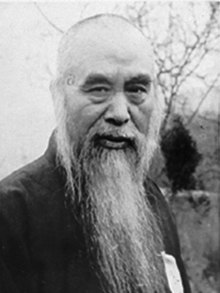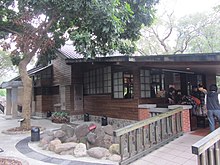Yu Youren
Yu Youren Republic of China | |
|---|---|
| Period | Republican China |
Yu Youren (Chinese: 于右任; pinyin: Yú Yòurèn); (April 11, 1879 – November 10, 1964) was a Chinese educator, scholar, calligrapher, and politician.
Early life
He was born on April 11, 1879, in the town of Hedaogang (
Revolutionary beginnings

In 1900, at the age of 22, Yu Youren wrote a letter for the Pacification Commissioner of Shaanxi, Cen Chunxuan, imploring him to take the opportunity of assassinating the Empress Dowager Cixi who was fleeing to Xi'an during the Boxer Rebellion, which would provide the impetus for true reform of the government, but Yu was stopped from sending it by his classmate Wang Linsheng. Yu wrote many poems venting anger and frustration with the government. These were collected into a book entitled Poetry Drafts from the Hall of Tears and Mockery. His friend Meng Yimin helped Yu to have it published.
In 1903, he passed the civil service examinations to become a Provincial Graduate (juren), but due to the satiric contents of Poetry Drafts from the Hall of Tears and Mockery, the government branded him a revolutionary. Wanted by the
In 1906, Yu fled to Japan and while there was able to meet Sun Yat-sen and the Tongmenghui through the introduction of Kang Xinfu and he thereafter officially joined the Tongmenghui. After returning to China in 1907, Yu started a newspaper called The National Herald (also known as the Shenzhou Daily), but its facilities were destroyed in a fire less than a year later. Yu's father died the following year. In March 1909, Yu established another newspaper called The People's Voice (Minzhu Bao) in Shanghai, strongly condemning the culture of corruption in government. Attracting the attention of officials, he was arrested and sent to jail, and the newspaper was closed in June 1909. Released from jail and still undaunted, he established another newspaper called The People's Sigh (Minxu Bao) but less than two months later it was shut down and he was thrown in jail again. In 1910, he established yet another newspaper called the Min Li Pai, the offices of which virtually served as the contact headquarters for the Tongmenghui.[2]
Post Xinhai Revolution

In 1912, Yu Youren was nominated to the post of Deputy Minister of Transportation and Communication, but less than three months later was forced to resign along with Sun Yat-sen's government. After
In 1936, Yu collected examples of Chinese characters and compiled them into the Thousand character essay in Standard Cursive Script as the book Standard Cursive Script, the first edition of which was published. Yu also donated his entire collection of more than three hundred rubbings from stele to the Xi'an Forest of Stele Museum.
In 1941, along with other members of the art and cultural world, Yu took the initiative to name the fifth day of the fifth lunar month as
Following the loss of Mainland China to Communist forces in 1949, Yu followed the Chinese Nationalist government to the island of Taiwan, which the Chinese government took from Japan at the end of World War II in 1945, at the age of 71.[4]
In Taiwan

In 1950, after the establishment of the
Calligraphy
Yu was a scholar of calligraphy and is regarded as one China's modern masters. His works in cursive and semi-cursive manner are intensely animated. He is perhaps best known for his calligraphy and published related works on the topic. Because his later years were spent in Taiwan, his writing style is very popular and his works are considered very desirable by collectors. Yu completed numerous inkworks, stone carvings, and title plaques while living in Taipei including works for the
The Pamir Snow Gnawing Association (帕米爾齧雪同志會) established a cultural park known as the
Gallery
-
Title Plaque by Yu Youren at Xingtian Temple in Taipei
-
Yangmingshan National Park, Taipei
-
Yangmingshan National Park, Taipei
-
Statue of Yu Youren at theSun Yat-sen Memorial Hallin Taipei
See also
- Lawrence Lau - Yu Youren's Grandson.
- Puru (artist)
- Chang Dai-chien
- Chatham Square, Manhattan
References
- ^ "千古一草圣:于右任的书法世界". Archived from the original on 2011-09-02.
- ^ "千古一草圣:于右任的书法世界". Archived from the original on 2011-09-02.
- ^ http://www.yuyouren.com/InfoShow.asp?ArticleID=449 [dead link]
- ^ "千古一草圣:于右任的书法世界". Archived from the original on 2011-09-02.
- ^ 玉山-{于}-右任像斷頭 元凶說始末, Liberty Times, February 13, 2007
- ^ "Archived copy" (PDF). Archived from the original (PDF) on 2011-07-18. Retrieved 2010-09-17.
{{cite web}}: CS1 maint: archived copy as title (link) - ^ "The Modern Sage of Cursive Script:Yu Youren and His World of Calligraphy". Archived from the original on 2011-09-02.
- ^ Poetry Exhorting the Pamir Comrades
- Yu Lian-hwa, An Encyclopedia of Chinese Artists, Shanghai, 1980, page 13.
External links
- Straddling East and West: Lin Yutang, a modern literatus: the Lin Yutang family collection of Chinese painting and calligraphy, an exhibition catalog from The Metropolitan Museum of Art Libraries (fully available online as PDF), which contains material on Yu Youren (see table of contents)
- Yu Youren's Tomb




